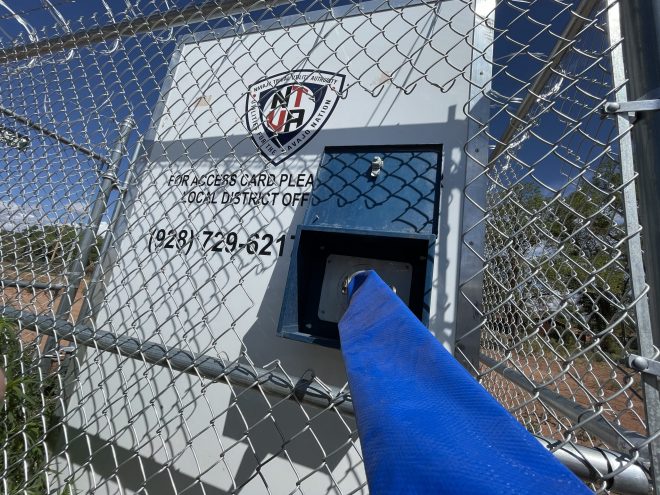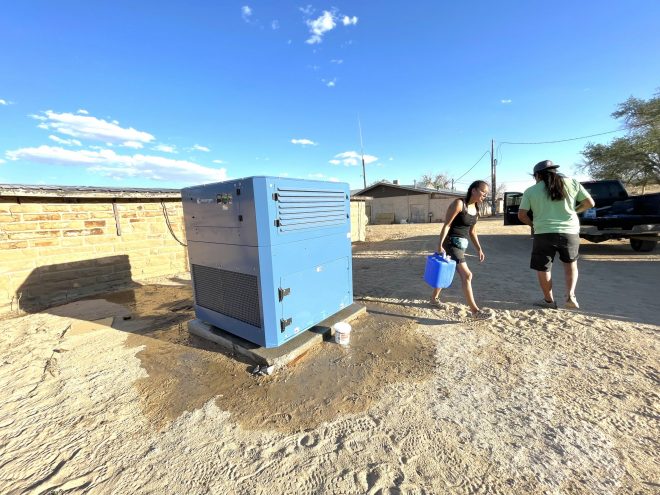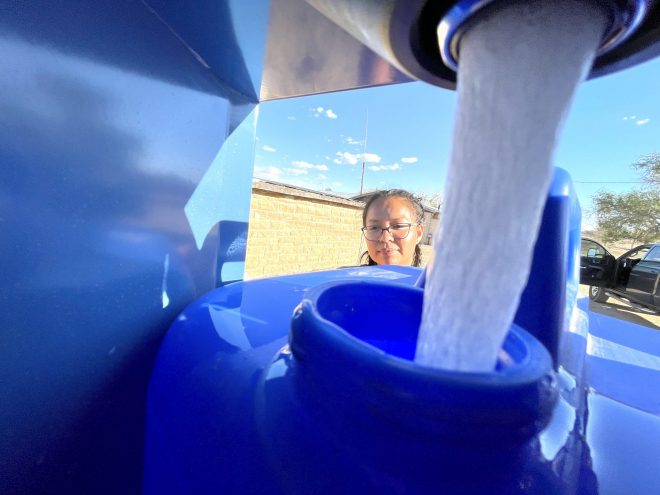
NTUA asks water customers to conserve water
WINDOW ROCK
Navajo Tribal Utility Authority is asking its customers to get into the habit of conserving the water they pay for and use.

Navajo Times | Donovan Quintero
A hose connects to a Navajo Tribal Utility Authority water-loading station through a chain-link fence on June 30 in Fort Defiance, Ariz. NTUA officials are asking their customers to conserve water. A week earlier, the enterprise issued a water restriction for water-loading station customers.
NTUA, the tribal utility enterprise that restricted the amount of water its water-loading stations could take, stated on Wednesday asking its consumers to get into the habit of conserving water.
The reasons: drought and extreme weather events.
“We are asking everyone to conserve water and hopefully we won’t have to enact any tighter restrictions,” said Rex Kontz, deputy general manager for NTUA. “Minimizing water use will avoid a crisis situation.”
Kontz has a point.
While a few areas in the Navajo Nation received nearly an inch of rain, much of the reservation received less than half an inch of precipitation, despite some places getting a heavy downpour, according to data from the Colorado Basin River Forecast Center.
On June 27, water levels in some NTUA tanks dropped 2 feet, Kontz said, because some water-loading station customers are filling their 100- to 200-gallon water tanks repeatedly throughout the day. He said NTUA found one customer took 6,000 gallons of water in two days. The significant drop in water levels prompted the water restriction to be issued.
Kontz said the water-loading stations are connected to the main water supply that provides water to its other water customers with water piping. The over-usage by water-loading station customers caused the water pressure to homes and businesses to drop.
The restriction, Kontz said, has been helping tank levels to recover.
“However, we are just starting the summer season and anticipate more hot weather through July, August, and even September,” he said. “What people don’t understand is that the groundwater, where you’re pumping water out of the ground, that’s recharge by snowfall. So, it soaks in slowly over time and that’s what recharges them.”
Kontz explained how wet monsoons play a role in resupplying groundwater.
“The monsoons would help by filling up local ponds and places where wildlife and livestock might water,” he said. “It doesn’t really help the groundwater and the supply for the community system. That’s some kind of misunderstanding because we’ve had a long-term drought.”
NTUA has approximately 39,000 customers and has 18 water-loading stations that serve an unknown number of additional customers who do not have access to a piped water system.
The tribal utility company provides water for communities along the San Juan River, from Fruitland, N.M. to Teec Nos Pos, Arizona. Those communities get water from the City of Farmington. The city issued a water shortage advisory and sent a letter to NTUA on May 27, informing them it would encourage its customers to reduce their water usage by 10%.
Chris Sypher, the community works director for the City of Farmington, said on June 7, the city uses up to 16 million gallons of water a day, and NTUA has access to up to 6 million gallons of water for its reservation customers during the summer.
According to the Navajo Department of Water Resource, the total consumption of drinking water is approximately more than 3.9 billion gallons annually. On average, water use on the reservation ranges from 10 gallons to 100 gallons a day. Neighboring border towns use up to 180 gallons a day.
This means that water usage on the reservation would increase to 160 gallons a day, or 2.9 trillion gallons a day, by 2040.
Space-age technology

Navajo Times | Donovan Quintero
Raina Dre Silver from Hard Rock, Ariz., carries a 5-gallon jug she filled with water collected from the air that is held inside the Watergen on July 6 in Hard Rock. The Watergen, which creates high-quality drinking water out of air, holds up to 50 gallons of water.
With water shortage becoming a potential concern in the future, space-age technology that captures water from the air is being developed.
Watergen, a company based in Israel, recently brought its miracle water-generating machine to Hard Rock, Arizona, where it has been set up to demonstrate how it works.
The machine, which looks like a large square blue metal box, requires 208 volts of electricity. For the most part, the water-generating machine sits idle until it turns on, sounding like a refrigerator. It seems to be a promising solution to the tribe’s water shortage woes.
Executive Director for Tó Nizhóní Ání Nicole Horseherder, who helped bring the machine to Hard Rock, an isolated community, said the water-generating machine is not going to be a water-savior for Navajos.
“No, not at all. Watergen is only one solution. It’s only one solution to the problem of water,” Horseherder said, who is from Tsé bik’i na’astsxélé, about 15 miles northeast of Hard Rock. “In the bigger picture, it will not solve all the water issues.
“NTUA has not been able to solve all the water and that’s obvious. People should understand that one company like NTUA, that just so happens to be able to drill wells and deliver water to people––doesn’t mean that they have all the answers, and we shouldn’t look to them to solve all the problems.”
Kontz agreed and said technology like Watergen’s would not be enough to sustain a home and was suitable only for emergency purposes. His concern was more for conserving the water.
Water restrictions
During the pandemic in 2020, volunteer groups like Water Warriors and DigDeep used water from various water sources on the reservation, including NTUA water-loading stations.
Koontz said he had a meeting with DigDeep, which provides service to its water customers in the Dilkon area. Kontz said he and his colleagues at NTUA do not know who DigDeep and Water Warriors are providing water services to. He said both DigDeep and Water Warriors went as far as installing elevated tanks at peoples’ homes.

Navajo Times | Donovan Quintero
Raina Dre Silver from Hard Rock, Ariz., watches the water collected by space-age technology called Watergen, which creates high-quality drinking water out of air, on July 6 in Hard Rock. Silver filled up three 5-gallon jugs.
“We don’t know how many they’ve done and where they’re hauling their waters and we didn’t,” Kontz said. “We weren’t asked for input on it. So, we had no control over those individuals. And we cautioned, very heavily about not doing those types of systems in certain areas.”
Horseherder said the chapter has not yet begun enforcing the NTUA water restrictions. She said the chapter wanted more information and to clarify what it means before it starts implementing it.
“The clouds come in every day, and it doesn’t rain. It’s been very, very hard not to be able to plant corn,” Horseherder said. “It makes life extra hard. Right now, we’re in midday and it’s over 100 degrees. We’ve never experienced temperatures so high, it’s just amazing. It’s hard.”
NTUA manages and operates the domestic, public water systems providing water for human consumption throughout the Navajo Nation. The Navajo Nation Water Resources Department oversees livestock wells and windmills.
NTUA recommends minimizing water usage by not washing parking lots or driveways, using potable water for construction purposes, watering lawns or gardens less than three times per week, and hauling less than 500 gallons – of potable water for remote home cistern systems – per day.
NTUA also recommends homeowners check for leaky faucets, leaky toilets, turn off the water while brushing their teeth, and taking fewer or shorter showers.
Horseherder said water conservation was a “community effort.”
“We have to do our part to respond to the drought. If we have livestock, we need to cut back,” Horseherder said. “The other thing that we have to do at this time is we need to go out and start land restoration projects.”








 Highway 264,
Highway 264, I-40, WB @ Winslow
I-40, WB @ Winslow